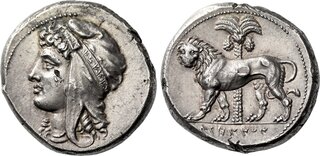| Numismatica Ars Classica > Auction 146 | Auction date: 8 May 2024 |
| Lot number: 2126 Price realized: This lot is for sale in an upcoming auction - Bid on this lot  | Show similar lots on CoinArchives Find similar lots in upcoming auctions on |
| Lot description: The Carthaginians in Italy, Sicily, Sardinia and North Africa. Tetradrachm, uncertain mint in Sicily circa 320, AR 26 mm, 17.02 g. Female head l., wearing oriental tiara with plain band before forehead. Rev. Lion walking l., with head facing; behind, palm tree with three clusters of dates. In exergue, s'mmhnt (People of the Camp) in Punic characters. Rizzo pl. LXVI, 7 (these dies). Jameson 911. SNG Lloyd 1628. Kraay-Hirmer pl. 73, 207 (these dies). Jenkins Punic Sicily III, 271. Extremely rare and in exceptional condition for the issue, among the finest specimens known. A portrait of enchanting beauty, the work of a very skilled master engraver, perfectly centred in high relief on very fresh metal and with a lovely light iridescent tone. An unobtrusive metal flaw on cheek and a small mark on lion's body, otherwise good extremely fine Ex NFA XXV, 1990, 44; Sotheby's 26 October 1993, Merrill-Lynch, 17; NAC 10, 1997, 189 and Triton III, 1999, 349 sales. This extraordinary tetradrachm seems to have been struck late in the 4th Century B.C., perhaps between 320 and 310, and very likely in the early part of that range. It belongs to a series containing just three sets of dies, each of which presents this interesting subject matter in a different way. Though each is spectacular and original in its own right, if one set of dies had to be chosen as the most accomplished, it certainly would be the one used to strike this coin. In his die study of the Siculo-Punic series, Jenkins was hard-pressed to find a place for this group among the other series of tetradrachms. Even if the superior style of engraving and the unusual subject matter were not obvious considerations, the fact that only three sets of dies were used and that they do not link with other issues (or even within themselves) demonstrates it was a special and isolated series. Aspects of the engraving style led Jenkins to conclude that they belonged at the end of his series 2d (head of Kore/horse animated before palm tree) or the beginning of his series 3 (dolphins around the head of Arethusa/horse head and palm tree). If linked with Jenkins' series 3, this coinage might be associated with preparations by the Carthaginian leader Hamilcar (son of Gison) to combat Agathocles; as such, Jenkins suggests they may have been minted for the 2,000 elite citizens who headed the new Carthaginian armada. A convincing interpretation of the designs has thus far been impossible to achieve. The head was traditionally described as Dido (Elissa), the legendary foundress of Carthage, but that identification has not found much support in recent decades. She may also be the personification of Libya, for that would match well with the prowling lion on the reverse. Jenkins objects to that idea, however, noting that celebrating an indigenous people subject to Carthaginian rule would not have been "consistent with Carthaginian nationalism". To the contrary, Robinson suggests Libya would have been an ideal subject if the bulk of the Carthaginian army at this time were comprised of mercenaries from Carthaginian Libya. Another possibility is that the Punic goddess Tanit (being in some ways the equivalent of the Greek goddess Artemis) is represented, and in many respects she seems to be the best choice. Estimate: 100000 CHF |  |



